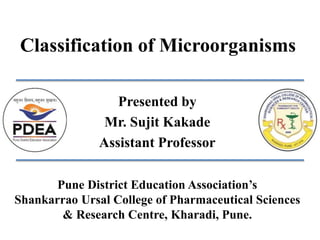
Classification of microorganism
- 1. Classification of Microorganisms Presented by Mr. Sujit Kakade Assistant Professor Pune District Education Association’s Shankarrao Ursal College of Pharmaceutical Sciences & Research Centre, Kharadi, Pune.
- 4. Taxonomy: It is the science that deal with logical arrangement of living thing into categories . 1)Aristotle classified living thing into plant and animals 2)Karls linaus classified living thing into kingdom Plantae and Animalia. He also devised binomial (genus and species) scheme of nomenclature. 3) In 18th century the German zoologist E.H. Haeckel proposed 3rd kingdom named as the protista. • Include unicellular m.o. typically they are neither plant nor animal. • Protista, include bacteria, fungi, algae, protozoa but virus not classified as protista. • Bacteria is classified as a lower protista and fungi, algae, protozoa classified as a higher protista. Classification of Micro-organisms
- 5. • In 1940 it was discovered in some cell e.g typical bacteria, the genetic material was not enclosed by nuclear membrane. • In other cells i.e (algae, fungi, protozoa) the nucleus was enclosed in membrane this resulted into division of organism Prokaryotes Eukaryotes • Bacteria are prokaryotic microbes (absence of nuclear membrane) • Fungi, algae, protozoa, plant and animal cell are eukaryotic microbes (presence of nuclear membrane)
- 8. The Three Domains of Life (Carl Woese, 1990) Starting in the early 1970s, Dr. Carl Woese, began to find evidence for a previously unknown group of prokaryotic organisms. These organisms lived in extreme environments - deep sea hydrothermal vents, "black smokers", hot springs, the Dead Sea, acid lakes, salt evaporation ponds - environments that scientists had never suspected would contain a profusion of life! Because they appeared prokaryotic, they were considered bacteria and named "archaebacteria" ('ancient' bacteria). However, became obvious from biochemical characteristics and DNA sequence analysis (Genetics) that there were numerous differences between these archaebacteria and other bacteria. Before long, it was realized that these archaebacteria were more closely related to the eukaryotes than to bacteria. Today, these bacteria have been renamed Archaea.
- 9. The three-domain system is a biological classification introduced by Carl Woese
- 11. Major Groups of Microorganisms 1.Bacteria 2.Viruses 3.Fungi 4.Protozoa 5.Algae
- 12. Bacteria Size: • Most bacteria range from 0.2–5.0 µm (micrometers) in diameter. Important Characteristics: • Prokaryotic • Unicellular • Simple Internal structure • Grow on artificial laboratory media • Reproduction asexual (mostly simple cell division, binary fission) Practical significance: • Some cause diseases • Some perform role in natural cycling of elements and increase soil fertility • Manufacture of valuable compounds in Industry. Examples: E. Coli, Salmonella typhi, Vibrio cholera, Staphylococcus aureus, Bacillus anthracis, Clostridium tetani, etc
- 14. Viruses Size: 0.015-0.2 μm Important Characteristics: • Do not grow on artificial media • Obligate intracellular parasites • Electron microscopy required to observe Practical significance: • Cause diseases in humans animals & plants • Also infect microorganisms like bacteria Examples: Rabies virus, Polio virus, Influenza virus, HIV, Corona virus, T-even bacteriophage, etc.
- 16. Fungi (Yeasts) Size: 5.0-10.0 μm Important Characteristics: • Eukaryotic & Non-motile • Unicellular • Grow on artificial laboratory media • Reproduction asexual (cell division/ budding) or sexual • Have Rigid Cell wall Made up of Chitin, Cellulose Practical significance: • Some cause diseases like Athlet’s foot, thrush • some are used as food supplements • Manufacture of alcoholic beverages Examples: Saccharomyces Cerevisae ,etc
- 18. Fungi (Molds) Size: 2.0-10.0 μm by several mm some are visible with naked eyes Important Characteristics: • Eukaryotic & Non-motile • Multicellular • • Many distinctive structural features (Filamentous structure ) showing Vegetative mycellium & Aerial mycellium • Cultivated on artificial laboratory media • Have Rigid Cell wall Made up of Chitin, Cellulose • Reproduction asexual or sexual Practical significance: • Decomposition of many materials • Industrial production of many chemicals like antibiotics • Can cause diseases, penicilliosis, otomycosis. Examples:Penicillium notatum, Aspergillus niger, etc.
- 20. Protozoa Size: 2.0-200 μm Important Characteristics: • Eukaryotic • Unicellular • Some cultivated on laboratory media while some are intracellular parasites • Reproduction asexual or sexual Practical significance: • Some cause diseases like Maleria, Sleeping sickness, etc • Food for aquatic animals Examples: Entamoeba histolytica, Plasmodium falciparum, Trypanosoma cruzi, etc.
- 22. Algae Size: 1.0 μm to several centimeters Important Characteristics: • Eukaryotic • Unicellular or Multicellular • Photosynthetic • Most occur in aquatic environments • Reproduction asexual or Sexual Practical significance: • Production of food in aquatic environments • Source of food and in Pharmaceuticals (Like Agar) • Some produce toxic substances Examples: Red algae, Green algae, etc
